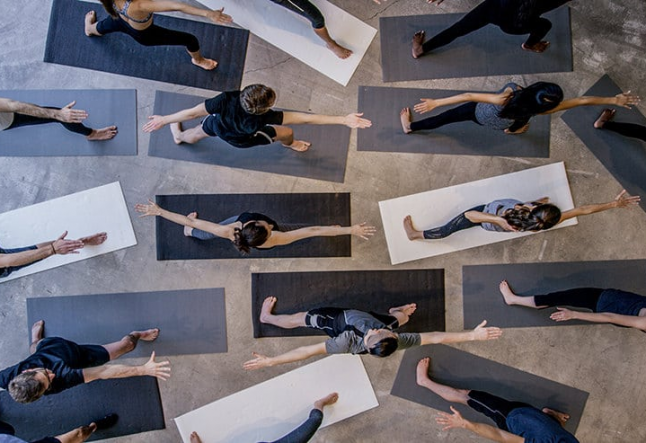online vs in person yoga teacher training

Years ago, I found myself at a quaint café, lost in thought over a steaming cup of chai, contemplating the pivotal decision of online vs in-person yoga teacher training.
Now, I invite you, dear reader, to join me in this moment of reflection. Picture yourself in your cozy nook, contemplating this significant choice.
Which path feels more like you?
Online training beckons with the allure of flexibility, allowing you to weave the ancient art of yoga into the fabric of your everyday life. Imagine practicing asanas in your living room, infused with the unique energy of your sanctuary. Conversely, in-person training offers the irreplaceable warmth of human connection, the collective breath of fellow yogis synchronizing with your own.
What does your heart whisper to you? Your yoga journey is as personal as the mat beneath your feet. Choose the path where you feel alive and most authentic.
This decision isn’t just about learning; it’s about connecting to your inner self and radiating that energy into the world. Embrace your choice with the same grace and strength you bring to each pose.
Remember, in the world of yoga, every path is sacred. Breathe in, breathe out, and let your yoga journey be a reflection of your deepest self.
The Evolution of Yoga Teacher Training
Yoga teacher training has evolved significantly over the years. Traditionally, teacher training was an immersive experience, with students living and studying under the guidance of a guru or lead teacher in a yoga school.
With advancements in technology, online yoga teacher training has emerged as a viable alternative, offering flexibility and accessibility without geographical constraints.
Also read >>> Best online yoga teacher training
In-Person Yoga Teacher Training: The Classic Approach
In-person yoga teacher training programs have long been the gold standard for aspiring yoga teachers.
These programs, often held in yoga studios or retreat centers, offer an immersive experience where trainees can practice teaching yoga, engage in real-time discussions about yoga philosophy, and foster connections within the yoga community.
Also read >>> The Rise of the Online Yoga Studio
The Benefits of Being There
The in-person training experience is rich with opportunities for hands-on learning and immediate feedback. Fellow students and instructors become part of your yoga journey, offering support and camaraderie.
The environment of a yoga studio provides a dedicated space for learning and practicing yoga asana, pranayama, and meditation.
The Rise of Online Yoga Teacher Training

Online yoga teacher training has gained popularity, especially for those with a busy schedule who still wish to deepen their practice or teach yoga.
These programs have brought yoga training to a broader audience, making becoming a certified yoga teacher more accessible.
Also read >>> Best Yoga Apps
Flexibility and Convenience Online
The most significant advantage of online yoga training is learning at your own pace and on your schedule.
Whether you’re managing a busy life or living far from a registered yoga school, online training options offer the chance to become part of the yoga teaching community without needing physical presence.
Comparing the Training Options
When considering yoga teacher training courses, the mode of delivery — online vs. in person — is crucial. Both methods aim to prepare you for a successful teaching career, but they do so in different ways, each with advantages and challenges.
Yoga Teacher Training Online: A Modern Twist on Traditional Learning
Online yoga teacher training courses are designed to provide the same quality of education as in-person programs.
These courses often include pre-recorded lectures, live sessions, and interactive forums.
Online training may offer lifetime access to course materials, allowing for continuous reference and learning.
The Online Yoga Community
While online yoga training may seem solitary, many programs work hard to create a sense of community.
Through discussion boards and group projects, online yoga teachers and fellow students can form bonds and share experiences just as they might in person.
In-Person Yoga Teacher Training: The Personal Touch
In-person yoga teacher training courses often emphasize personalized instruction and the opportunity to develop your teaching style through practice teaching sessions.
The immediate feedback from instructors and other students is invaluable in refining your skills.
The Real-World Yoga Studio Experience
Experiencing the nuances of teaching yoga in a yoga studio setting is one of the main benefits of in-person training.
There’s an unreplicable energy in a room full of yoga practitioners moving and breathing together, which many find essential for their learning style.
Yoga Teacher Certification: Quality Across the Board
Whether online or in person, a comprehensive yoga teacher training program should cover all the necessary areas: yoga philosophy, anatomy, teaching methodology, and yoga practice.
Both types of training should prepare you to become a certified yoga instructor, capable of offering yoga classes that are safe, effective, and inspiring.
The Role of the Yoga Alliance
Yoga Alliance is a critical player in the yoga world, offering a registry of teachers and schools that meet their specific standards.
Online and in-person yoga training can lead to becoming a registered yoga teacher (RYT), as long as the school is a registered yoga school with Yoga Alliance.
Delving Deeper: Online Teacher Training vs. In-Person Experience

Choosing between online and in-person yoga teacher training often involves individual circumstances and preferences.
Both paths lead to the sacred goal of deepening one’s yoga practice and acquiring the skills to teach others, yet they present unique learning environments and experiences.
The Structure of Yoga Teacher Training
Typically, online and in-person hour yoga teacher training programs are structured to comply with the standards set by the Yoga Alliance, ensuring a comprehensive education regardless of the format.
A 200-hour yoga teacher training course serves as the foundational level, whether it’s conducted in a studio or through an online platform.
Curriculum Comparison
In a yoga teacher training course, you can expect to cover extensive ground, including yoga philosophy, anatomy, asana practice, and teaching methodology.
An online yoga teacher training certification is designed to offer the same curriculum as an in-person course, often supplemented with digital resources for a richer online learning experience.
Online Teacher Training: The Digital Classroom
Online teacher training courses bring the classroom to you.
Through pre-recorded video lectures, live interactive sessions, and digital course materials, students can absorb knowledge in a format that suits their learning style.
The Convenience of Online Courses
The flexibility of online courses is particularly advantageous for those with a busy schedule.
Aspiring yoga teachers can log in and learn at times that fit their lifestyle, often with the option to review materials multiple times for better retention.
The Dynamics of Online Learning
Online learning platforms are increasingly sophisticated, offering features like discussion forums, video conferencing, and interactive assignments that foster a collaborative learning environment.
This digital approach can cater to various learning styles, providing visual, auditory, and kinesthetic learning opportunities.
Accessibility of Online Teacher Training Courses
The digital nature of online teacher training courses means they are accessible to a global audience.
This universal access not only breaks down geographical barriers but also enriches the learning experience by exposing students to diverse perspectives and teaching styles.
Certification and Beyond
Whether online or in-person, the culmination of a yoga teacher training course is often marked by a certification process.
This may include written exams, practical teaching assessments, and a demonstration of yoga practice proficiency.
An online yoga teacher training certification holds the same merit as one obtained in person, provided it comes from a credible source and meets industry standards.
Yoga Teacher Training Certification: A Milestone

Receiving a yoga teacher training certification is a significant milestone.
It signifies a readiness to begin teaching yoga and a commitment to uphold the standards of the yoga profession.
This certification confirms that online graduates’ virtual education has met the same rigorous criteria as traditional in-person programs.
Building Community and Practice in Teacher Training
The sense of community and the opportunity for hands-on practice are often decisive factors when choosing between online and in-person yoga teacher training.
Both formats strive to create an environment conducive to learning, yet they do so in distinctly different ways.
Fostering Community in Yoga Teacher Training
In-person yoga teacher training naturally offers a community atmosphere.
Trainees develop relationships with peers and instructors through daily interactions, shared experiences, and the common physical space of a yoga studio or retreat center.
Community in the Online Space
Online yoga teacher training, on the other hand, builds community digitally. Through live webinars, group discussions, and partner exercises, online courses foster a sense of belonging and connectedness among students from across the globe.
This virtual community can be surprisingly tight-knit, with students often forming study groups and supporting each other’s learning journeys.
Practice Teaching: Online vs In-Person

Practicing teaching is a vital component of any teacher training program. In-person programs offer immediate feedback and the ability to adjust teaching style based on real-time observations.
Online teacher training courses approach practice teaching by using video submissions, peer reviews, and live online teaching sessions to simulate the in-person experience as closely as possible.
Real-Time Feedback
The advantage of in-person feedback is its immediacy and directness.
Being able to see and correct alignment, adjust the pacing of a class, or experiment with different cues can rapidly enhance a trainee’s teaching skills.
Support Systems in Teacher Training
A robust support system is crucial for yoga teacher trainees, and in-person training often provides this through daily access to lead teachers and mentors.
Online teacher training courses must be more creative, offering scheduled one-on-one check-ins, mentorship programs, and responsive online support to ensure trainees feel guided and cared for throughout their journey.
Preparing for a Teaching Career
Online and in-person yoga teacher training prepares students for a teaching career, but they may prioritize different skill sets.
In-person training focuses more on the dynamics of leading a live class, while online training emphasizes the technical aspects of running online yoga classes.
Adaptability and Resilience in Online Learning
Online learning teaches adaptability and resilience, as trainees must navigate technology, manage their schedules, and often balance training with other life commitments.
These skills are increasingly relevant today, where yoga teachers need to be versatile and resourceful.
The Certification Goal
Regardless of the format, the goal of any yoga teacher training course is to provide a comprehensive education that culminates in certification.
This certification is a testament to the trainee’s dedication and readiness to join the global community of certified yoga teachers.
Same Quality, Different Mediums
Online and in-person teacher training courses aim to uphold the same quality standards.
Reputable programs, whether delivered digitally or face-to-face, follow curriculums that meet or exceed the benchmarks of Yoga Alliance and other accrediting bodies.
Navigating the Transition: From Trainee to Yoga Teacher
The transition from a yoga teacher trainee to a fully-fledged yoga teacher is a pivotal phase, filled with excitement and challenges.
This is when the essence of your yoga teacher training—whether online or in person—starts manifesting in the real world.
Stepping into the Yoga Industry
Today’s yoga industry is as diverse as it is widespread, with numerous exploration opportunities and paths.
Newly certified teachers must navigate this landscape with an understanding of both the traditional aspects of yoga and the modern business practices that sustain a teaching career.
Building a Personal Brand
In online and in-person training environments, trainees are encouraged to consider their teaching philosophy and niche early on.
This can include specializing in a particular style of yoga, like vinyasa or yin yoga, or focusing on a specific demographic.
Establishing a personal brand helps new teachers stand out and attract students who resonate with their unique approach.
The Yoga Teaching Marketplace
Yoga teachers today need to be adept not only at teaching yoga but also at marketing their services.
The rise of online yoga has expanded the marketplace, allowing teachers to reach a global audience. Whether promoting in-person classes at a local yoga studio or online courses from home, understanding the nuances of digital marketing is essential.
Utilizing Online Platforms

Social media, YouTube, and various yoga-specific sites for online yoga teachers become invaluable tools for connecting with potential students.
Online teacher training courses often include practical modules leveraging these platforms, providing a solid foundation for a successful online teaching career.
Creating Sustainable Teaching Practices
A sustainable teaching career in yoga requires a balance of passion, skill, and business acumen. Teachers must manage their schedules, set fair pricing, and create valuable offerings that keep students engaged over the long term.
Diversifying Income Streams
Many yoga teachers find success by diversifying their income streams.
This could include teaching in-person classes, offering online sessions, hosting workshops, and providing private instruction.
Teacher training programs, especially those online, often discuss these aspects, preparing trainees for the multifaceted nature of a yoga teaching career.
Lifelong Learning and Development
The best yoga teachers remain students at heart, constantly learning and evolving their practice.
Continuing education, whether through additional certifications, workshops, or personal study, is critical to maintaining the depth and freshness of one’s teaching.
The Role of Yoga Alliance and Continuing Education
Yoga Alliance and other similar organizations offer ongoing education and professional development resources.
They also provide a framework for maintaining certification through continuing education credits, ensuring teachers stay current with their knowledge and skills.
The Supportive Role of the Yoga Community
As you embark on your teaching career, the support of the yoga community becomes invaluable. Whether meeting in person or online, fellow students from your training can become colleagues and friends in the industry.
Many yoga studios and online forums offer spaces for teachers to share experiences, advice, and opportunities.
Mentorship and Growth
Seeking mentorship from more experienced teachers can provide guidance and inspiration. Mentorship is often a component of teacher training courses and can continue informally as new teachers establish themselves in the field.
Frequently Asked Questions
Is online yoga teacher training worth it?
Online yoga teacher training is indeed worth it for many students. It offers flexibility, accessibility, and often a more affordable option while still providing a comprehensive education in yoga.
It can be an excellent choice for those who cannot attend in-person training due to geographic or time constraints or for those who prefer the online learning format.
Is it OK to learn yoga online?
Learning yoga online is a valid option and can be effective.
Many reputable yoga teachers offer online yoga classes and courses, allowing students to practice and learn from the comfort of their own homes. It can also be a great supplement to in-person learning.
What is the difference between a registered yoga teacher and a certified yoga teacher?
A certified yoga teacher has completed a yoga teacher training course and received a certificate from the program.
A registered yoga teacher has taken the additional step of registering with an organization like Yoga Alliance, which often requires the completion of an accredited training program.
What is the difference between 200-hour and 500-hour yoga teacher training?
A 200-hour yoga teacher training is the foundational course for teaching yoga, covering all the basics necessary to start teaching.
A 500-hour training is a more advanced program that usually includes the initial 200 hours plus an additional 300 hours of more in-depth study, which can lead to more advanced teaching skills and knowledge.



